tow TOYOTA BZ4X 2022 (in English) Owner's Guide
[x] Cancel search | Manufacturer: TOYOTA, Model Year: 2022, Model line: BZ4X, Model: TOYOTA BZ4X 2022Pages: 674, PDF Size: 120.02 MB
Page 293 of 674
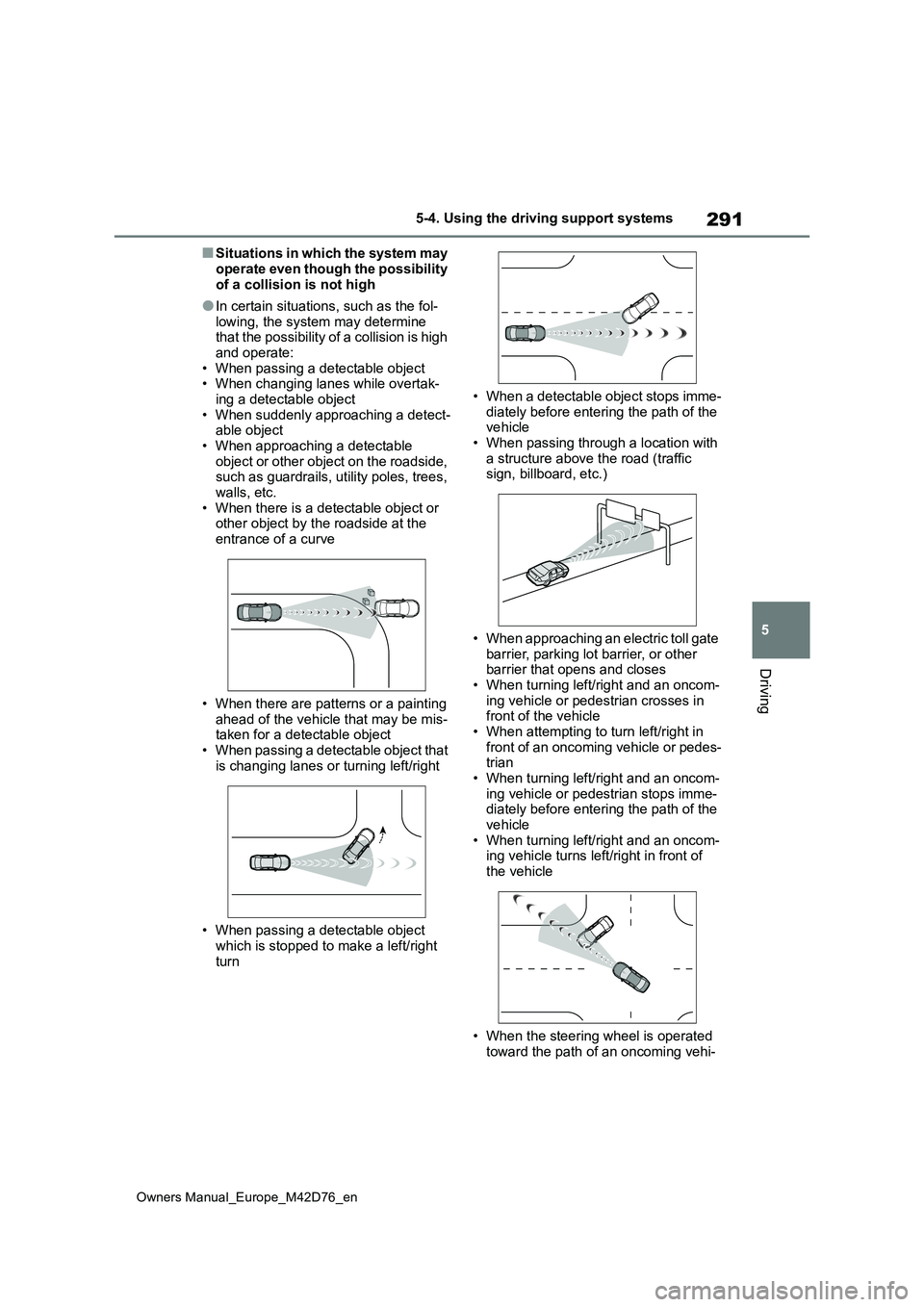
291
5
Owners Manual_Europe_M42D76_en
5-4. Using the driving support systems
Driving
■Situations in which the system may
operate even though the possibility of a collision is not high
●In certain situations, such as the fol-lowing, the system may determine that the possibility of a collision is high
and operate: • When passing a detectable object• When changing lanes while overtak-
ing a detectable object • When suddenly approaching a detect-able object
• When approaching a detectable object or other object on the roadside, such as guardrails, utility poles, trees,
walls, etc. • When there is a detectable object or other object by the roadside at the
entrance of a curve
• When there are patterns or a painting
ahead of the vehicle that may be mis- taken for a detectable object• When passing a detectable object that
is changing lanes or turning left/right
• When passing a detectable object
which is stopped to make a left/right turn
• When a detectable object stops imme-
diately before entering the path of the vehicle• When passing through a location with
a structure above the road (traffic sign, billboard, etc.)
• When approaching an electric toll gate barrier, parking lot barrier, or other barrier that opens and closes
• When turning left/right and an oncom- ing vehicle or pedestrian crosses in front of the vehicle
• When attempting to turn left/right in front of an oncoming vehicle or pedes-trian
• When turning left/right and an oncom- ing vehicle or pedestrian stops imme-diately before entering the path of the
vehicle • When turning left/right and an oncom-ing vehicle turns left/right in front of
the vehicle
• When the steering wheel is operated
toward the path of an oncoming vehi-
Page 300 of 674
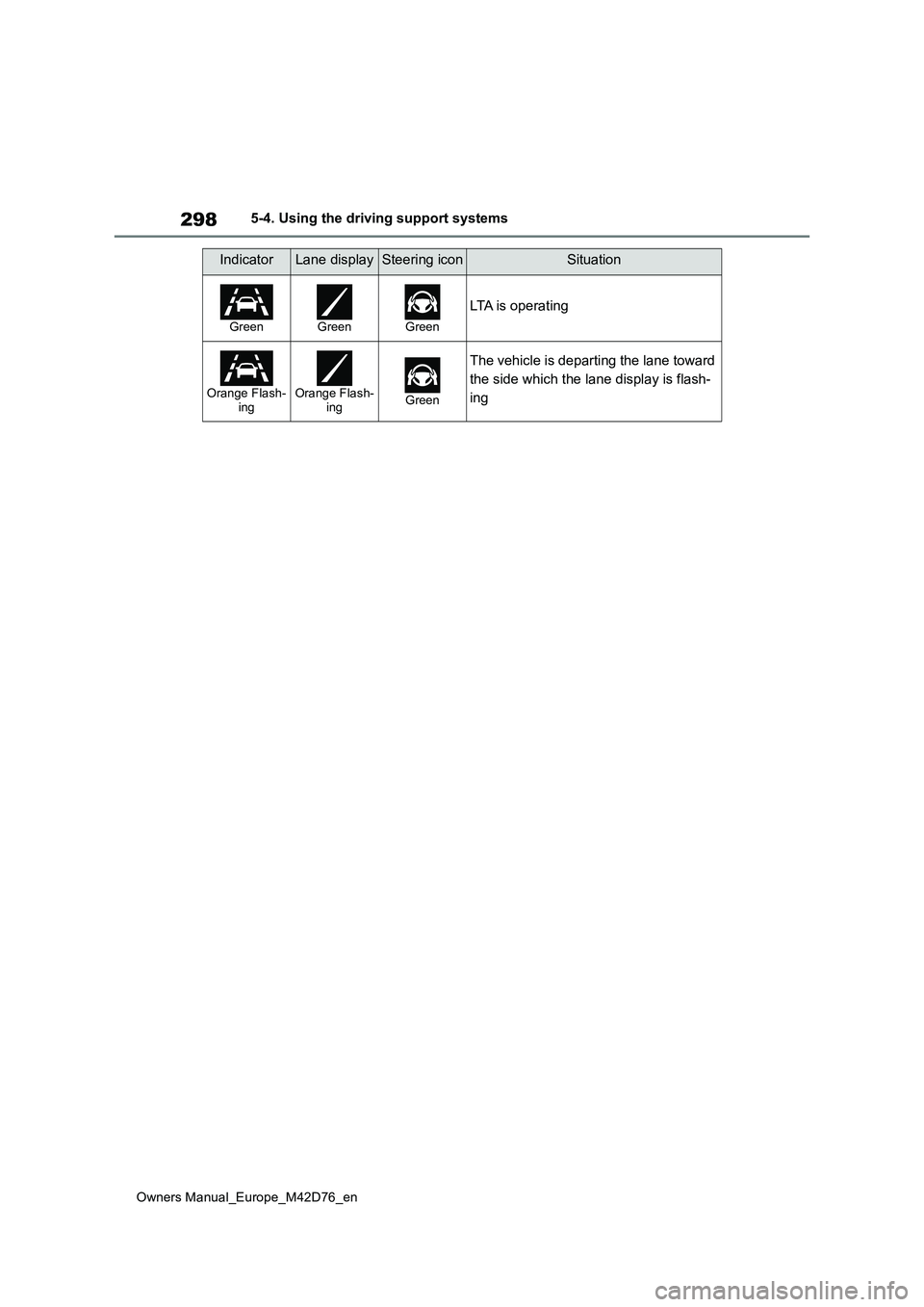
298
Owners Manual_Europe_M42D76_en
5-4. Using the driving support systems
GreenGreenGreen
LTA is operating
Orange Flash- ingOrange Flash-ingGreen
The vehicle is departing the lane toward
the side which the lane display is flash-
ing
IndicatorLane displaySteering iconSituation
Page 326 of 674
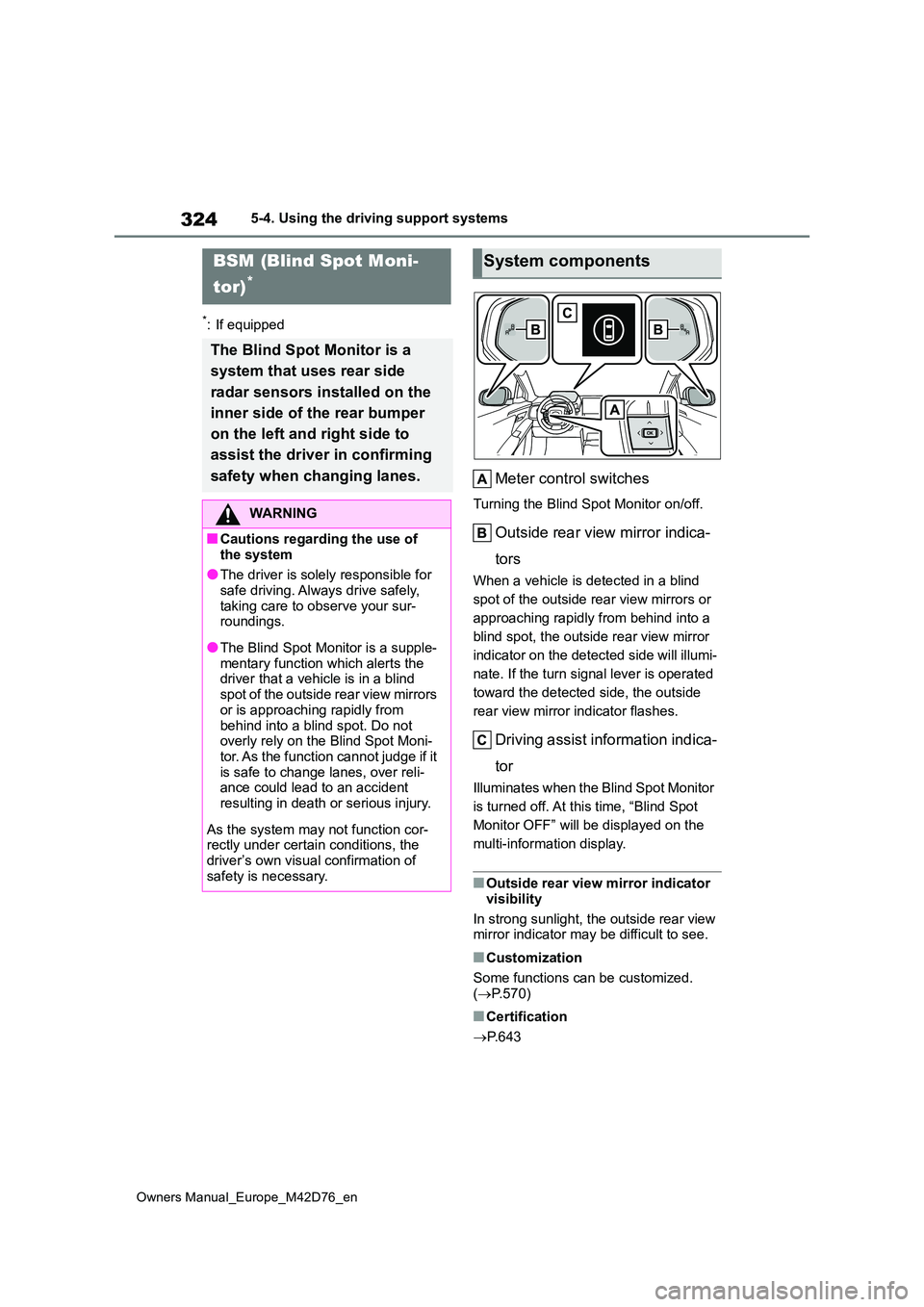
324
Owners Manual_Europe_M42D76_en
5-4. Using the driving support systems
*: If equipped
Meter control switches
Turning the Blind Spot Monitor on/off.
Outside rear view mirror indica-
tors
When a vehicle is detected in a blind
spot of the outside rear view mirrors or
approaching rapidly from behind into a
blind spot, the outside rear view mirror
indicator on the detected side will illumi-
nate. If the turn signal lever is operated
toward the detected side, the outside
rear view mirror indicator flashes.
Driving assist information indica-
tor
Illuminates when the Blind Spot Monitor
is turned off. At this time, “Blind Spot
Monitor OFF” will be displayed on the
multi-information display.
■Outside rear view mirror indicator
visibility
In strong sunlight, the outside rear view mirror indicator may be difficult to see.
■Customization
Some functions can be customized. ( P.570)
■Certification
P. 6 4 3
BSM (Blind Spot Moni-
tor)*
The Blind Spot Monitor is a
system that uses rear side
radar sensors installed on the
inner side of the rear bumper
on the left and right side to
assist the driver in confirming
safety when changing lanes.
WARNING
■Cautions regarding the use of
the system
●The driver is solely responsible for safe driving. Always drive safely,
taking care to observe your sur- roundings.
●The Blind Spot Monitor is a supple-mentary function which alerts the driver that a vehicle is in a blind
spot of the outside rear view mirrors or is approaching rapidly from
behind into a blind spot. Do not overly rely on the Blind Spot Moni-tor. As the function cannot judge if it
is safe to change lanes, over reli- ance could lead to an accident resulting in death or serious injury.
As the system may not function cor- rectly under certain conditions, the
driver’s own visual confirmation of safety is necessary.
System components
Page 330 of 674
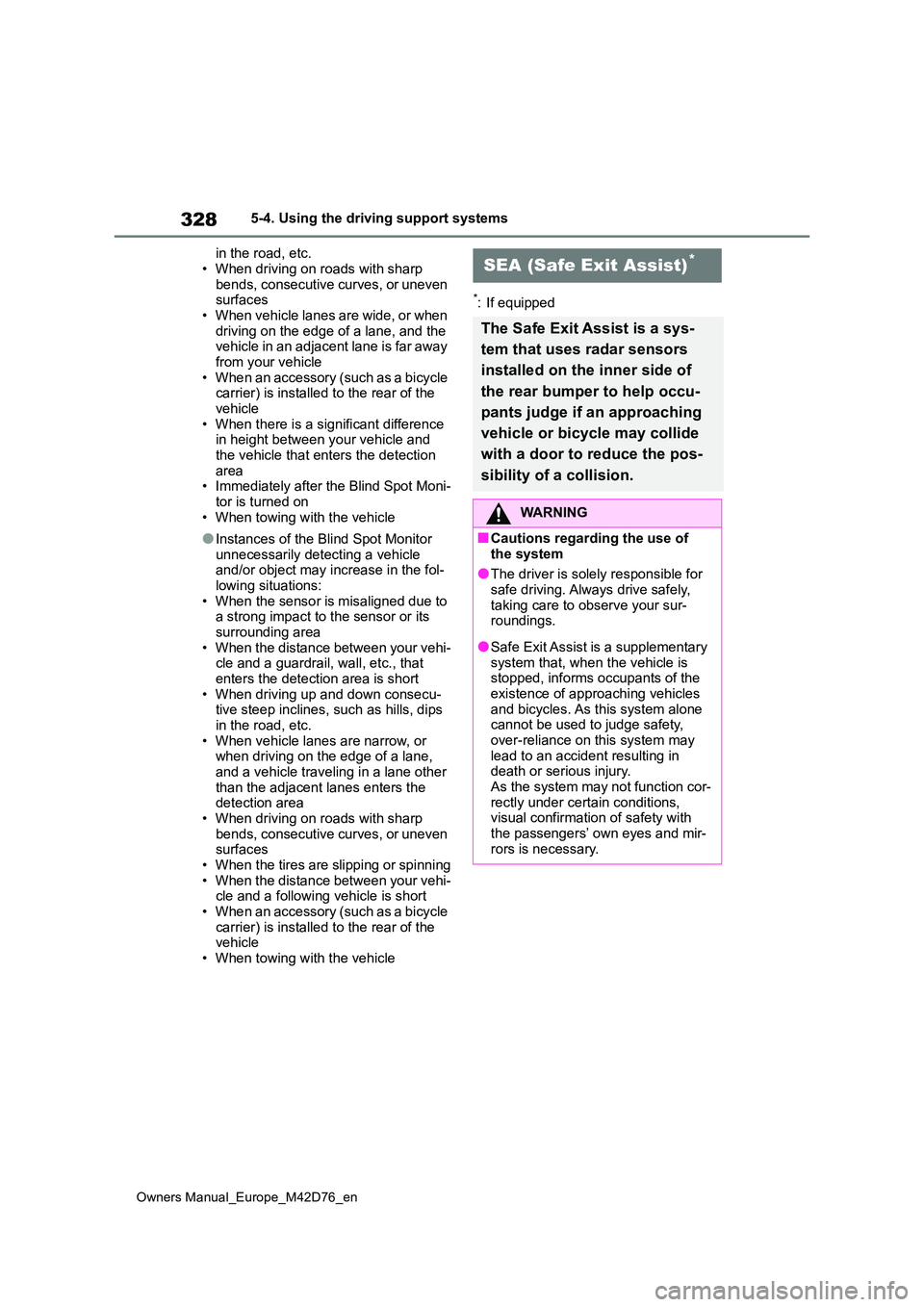
328
Owners Manual_Europe_M42D76_en
5-4. Using the driving support systems
in the road, etc.
• When driving on roads with sharp bends, consecutive curves, or uneven surfaces
• When vehicle lanes are wide, or when driving on the edge of a lane, and the vehicle in an adjacent lane is far away
from your vehicle • When an accessory (such as a bicycle carrier) is installed to the rear of the
vehicle • When there is a significant difference in height between your vehicle and
the vehicle that enters the detection area• Immediately after the Blind Spot Moni-
tor is turned on • When towing with the vehicle
●Instances of the Blind Spot Monitor unnecessarily detecting a vehicle and/or object may increase in the fol-
lowing situations: • When the sensor is misaligned due to a strong impact to the sensor or its
surrounding area • When the distance between your vehi-cle and a guardrail, wall, etc., that
enters the detection area is short • When driving up and down consecu-tive steep inclines, such as hills, dips
in the road, etc. • When vehicle lanes are narrow, or when driving on the edge of a lane,
and a vehicle traveling in a lane other than the adjacent lanes enters the detection area
• When driving on roads with sharp bends, consecutive curves, or uneven surfaces
• When the tires are slipping or spinning • When the distance between your vehi-cle and a following vehicle is short
• When an accessory (such as a bicycle carrier) is installed to the rear of the vehicle
• When towing with the vehicle
*: If equipped
SEA (Safe Exit Assist)*
The Safe Exit Assist is a sys-
tem that uses radar sensors
installed on the inner side of
the rear bumper to help occu-
pants judge if an approaching
vehicle or bicycle may collide
with a door to reduce the pos-
sibility of a collision.
WARNING
■Cautions regarding the use of
the system
●The driver is solely responsible for safe driving. Always drive safely,
taking care to observe your sur- roundings.
●Safe Exit Assist is a supplementary system that, when the vehicle is stopped, informs occupants of the
existence of approaching vehicles and bicycles. As this system alone cannot be used to judge safety,
over-reliance on this system may lead to an accident resulting in death or serious injury.
As the system may not function cor- rectly under certain conditions, visual confirmation of safety with
the passengers’ own eyes and mir- rors is necessary.
Page 334 of 674
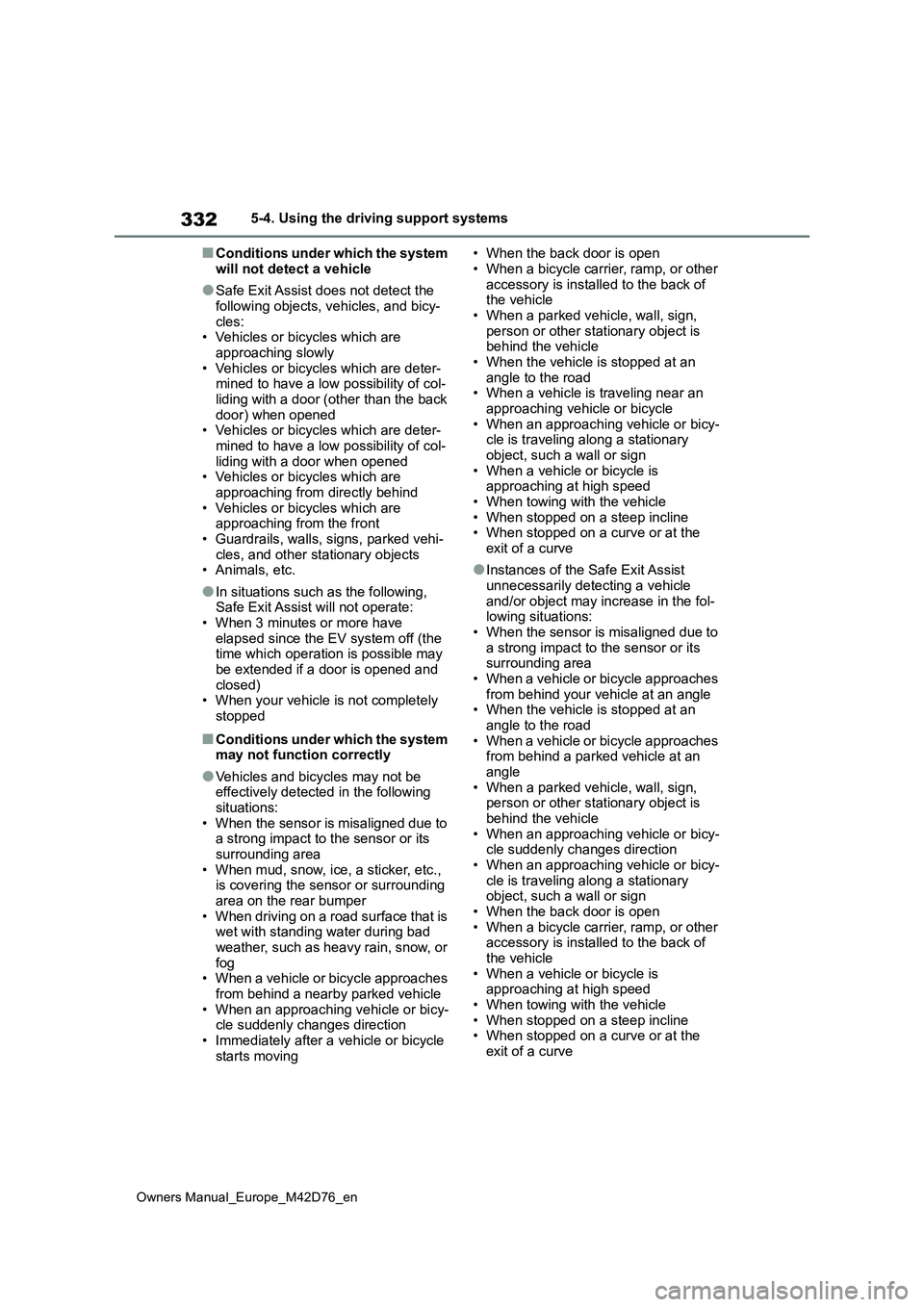
332
Owners Manual_Europe_M42D76_en
5-4. Using the driving support systems
■Conditions under which the system
will not detect a vehicle
●Safe Exit Assist does not detect the
following objects, vehicles, and bicy- cles:• Vehicles or bicycles which are
approaching slowly • Vehicles or bicycles which are deter-mined to have a low possibility of col-
liding with a door (other than the back door) when opened• Vehicles or bicycles which are deter-
mined to have a low possibility of col- liding with a door when opened• Vehicles or bicycles which are
approaching from directly behind • Vehicles or bicycles which are approaching from the front
• Guardrails, walls, signs, parked vehi- cles, and other stationary objects• Animals, etc.
●In situations such as the following, Safe Exit Assist will not operate:
• When 3 minutes or more have elapsed since the EV system off (the time which operation is possible may
be extended if a door is opened and closed)• When your vehicle is not completely
stopped
■Conditions under which the system may not function correctly
●Vehicles and bicycles may not be effectively detected in the following situations:
• When the sensor is misaligned due to a strong impact to the sensor or its surrounding area
• When mud, snow, ice, a sticker, etc., is covering the sensor or surrounding area on the rear bumper
• When driving on a road surface that is wet with standing water during bad weather, such as heavy rain, snow, or
fog • When a vehicle or bicycle approaches from behind a nearby parked vehicle
• When an approaching vehicle or bicy- cle suddenly changes direction• Immediately after a vehicle or bicycle
starts moving
• When the back door is open
• When a bicycle carrier, ramp, or other accessory is installed to the back of the vehicle
• When a parked vehicle, wall, sign, person or other stationary object is behind the vehicle
• When the vehicle is stopped at an angle to the road• When a vehicle is traveling near an
approaching vehicle or bicycle • When an approaching vehicle or bicy-cle is traveling along a stationary
object, such a wall or sign • When a vehicle or bicycle is approaching at high speed
• When towing with the vehicle • When stopped on a steep incline• When stopped on a curve or at the
exit of a curve
●Instances of the Safe Exit Assist
unnecessarily detecting a vehicle and/or object may increase in the fol-lowing situations:
• When the sensor is misaligned due to a strong impact to the sensor or its surrounding area
• When a vehicle or bicycle approaches from behind your vehicle at an angle• When the vehicle is stopped at an
angle to the road • When a vehicle or bicycle approaches from behind a parked vehicle at an
angle • When a parked vehicle, wall, sign, person or other stationary object is
behind the vehicle • When an approaching vehicle or bicy-cle suddenly changes direction
• When an approaching vehicle or bicy- cle is traveling along a stationary object, such a wall or sign
• When the back door is open • When a bicycle carrier, ramp, or other accessory is installed to the back of
the vehicle • When a vehicle or bicycle is approaching at high speed
• When towing with the vehicle • When stopped on a steep incline• When stopped on a curve or at the
exit of a curve
Page 338 of 674
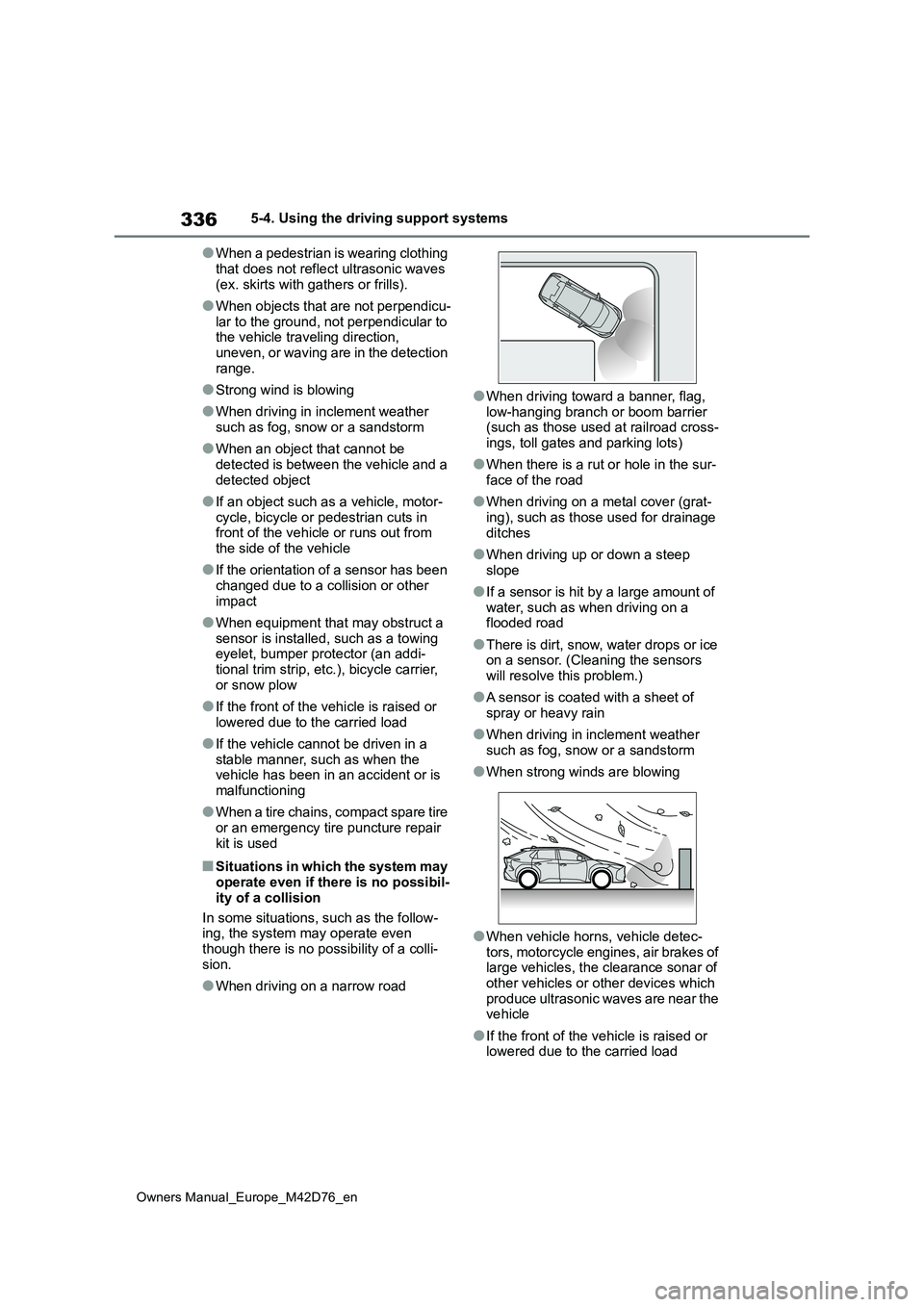
336
Owners Manual_Europe_M42D76_en
5-4. Using the driving support systems
●When a pedestrian is wearing clothing
that does not reflect ultrasonic waves (ex. skirts with gathers or frills).
●When objects that are not perpendicu-lar to the ground, not perpendicular to the vehicle traveling direction,
uneven, or waving are in the detection range.
●Strong wind is blowing
●When driving in inclement weather
such as fog, snow or a sandstorm
●When an object that cannot be
detected is between the vehicle and a detected object
●If an object such as a vehicle, motor-cycle, bicycle or pedestrian cuts in front of the vehicle or runs out from
the side of the vehicle
●If the orientation of a sensor has been
changed due to a collision or other impact
●When equipment that may obstruct a sensor is installed, such as a towing eyelet, bumper protector (an addi-
tional trim strip, etc.), bicycle carrier, or snow plow
●If the front of the vehicle is raised or lowered due to the carried load
●If the vehicle cannot be driven in a stable manner, such as when the vehicle has been in an accident or is
malfunctioning
●When a tire chains, compact spare tire
or an emergency tire puncture repair kit is used
■Situations in which the system may operate even if there is no possibil-
ity of a collision
In some situations, such as the follow- ing, the system may operate even
though there is no possibility of a colli- sion.
●When driving on a narrow road
●When driving toward a banner, flag,
low-hanging branch or boom barrier (such as those used at railroad cross-ings, toll gates and parking lots)
●When there is a rut or hole in the sur-face of the road
●When driving on a metal cover (grat-ing), such as those used for drainage
ditches
●When driving up or down a steep
slope
●If a sensor is hit by a large amount of
water, such as when driving on a flooded road
●There is dirt, snow, water drops or ice on a sensor. (Cleaning the sensors will resolve this problem.)
●A sensor is coated with a sheet of spray or heavy rain
●When driving in inclement weather such as fog, snow or a sandstorm
●When strong winds are blowing
●When vehicle horns, vehicle detec-tors, motorcycle engines, air brakes of large vehicles, the clearance sonar of
other vehicles or other devices which produce ultrasonic waves are near the vehicle
●If the front of the vehicle is raised or lowered due to the carried load
Page 348 of 674
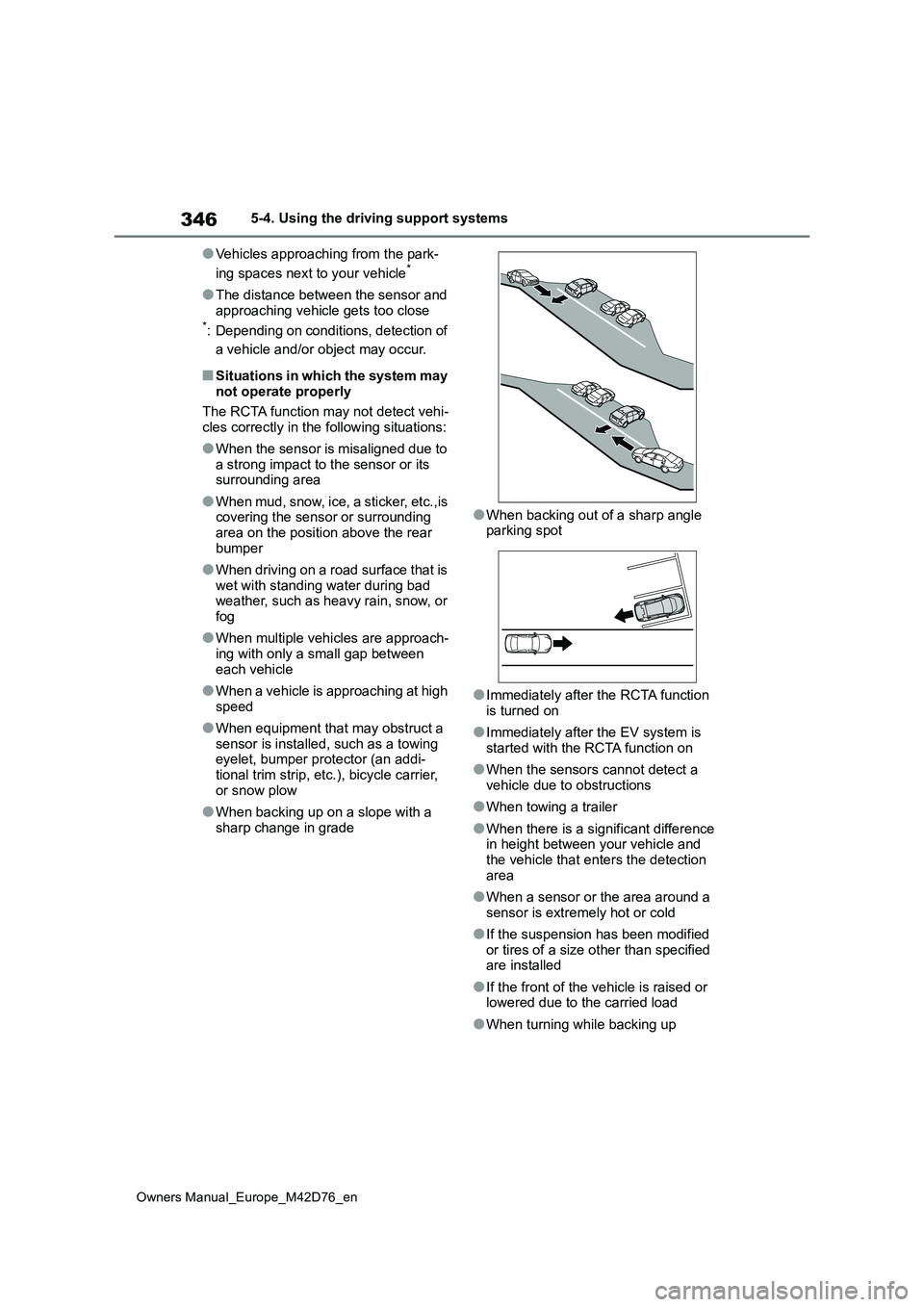
346
Owners Manual_Europe_M42D76_en
5-4. Using the driving support systems
●Vehicles approaching from the park-
ing spaces next to your vehicle*
●The distance between the sensor and
approaching vehicle gets too close*: Depending on conditions, detection of
a vehicle and/or object may occur.
■Situations in which the system may not operate properly
The RCTA function may not detect vehi-
cles correctly in the following situations:
●When the sensor is misaligned due to
a strong impact to the sensor or its surrounding area
●When mud, snow, ice, a sticker, etc.,is covering the sensor or surrounding area on the position above the rear
bumper
●When driving on a road surface that is
wet with standing water during bad weather, such as heavy rain, snow, or fog
●When multiple vehicles are approach-ing with only a small gap between
each vehicle
●When a vehicle is approaching at high
speed
●When equipment that may obstruct a
sensor is installed, such as a towing eyelet, bumper protector (an addi-tional trim strip, etc.), bicycle carrier,
or snow plow
●When backing up on a slope with a
sharp change in grade
●When backing out of a sharp angle parking spot
●Immediately after the RCTA function is turned on
●Immediately after the EV system is started with the RCTA function on
●When the sensors cannot detect a vehicle due to obstructions
●When towing a trailer
●When there is a significant difference in height between your vehicle and the vehicle that enters the detection
area
●When a sensor or the area around a
sensor is extremely hot or cold
●If the suspension has been modified
or tires of a size other than specified are installed
●If the front of the vehicle is raised or lowered due to the carried load
●When turning while backing up
Page 349 of 674

347
5
Owners Manual_Europe_M42D76_en
5-4. Using the driving support systems
Driving
●When a vehicle turns into the detec-
tion area
■Situations in which the system may
operate even if there is no possibil- ity of a collision
Instances of the RCTA function unnec-
essary detecting a vehicle and/or object may increase in the following situations:
●When the parking space faces a street and vehicles are being driven on the street
●When the distance between your vehi-cle and metal objects, such as a
guardrail, wall, sign, or parked vehicle, which may reflect electrical waves toward the rear of the vehicle, is short
●When equipment that may obstruct a
sensor is installed, such as a towing eyelet, bumper protector (an addi-tional trim strip, etc.), bicycle carrier,
or snow plow
●When a vehicle passes by the side of
your vehicle
●When a detected vehicle turns while
approaching the vehicle
●When there are spinning objects near
your vehicle such as the fan of an air conditioning unit
●When water is splashed or sprayed toward the rear bumper, such as from a sprinkler
●Moving objects (flags, exhaust fumes, large rain droplets or snowflakes, rain
water on the road surface, etc.)
●When the distance between your vehi-
cle and a guardrail, wall, etc., that enters the detection area is short
●Gratings and gutters
Page 353 of 674

351
5
Owners Manual_Europe_M42D76_en
5-4. Using the driving support systems
Driving
ing such as a rain coat, long skirt, etc.,
making their silhouette obscure • Pedestrians whose body is partially hidden by an object, such as a cart or
umbrella • Pedestrians which are obscured by darkness, such as at night
●In some situations, such as the follow-ing, pedestrians may not be detected
by the rear camera detection function, preventing the function from operating properly:
• When backing up in inclement weather (rain, snow, fog, etc.)• When the rear camera is obscured
(dirt, snow, ice, etc., are attached) or scratched• When a very bright light, such as the
sun, or the headlights of another vehi- cle, shines directly into the rear cam-era
• When backing up in a place where the surrounding brightness changes sud-denly, such as at the entrance or exit
of a garage or underground parking lot• When backing up in a dim environ-
ment such as during dusk or in an underground parking lot• When the camera position and direc-
tion are deviated • When a towing hook is attached• When water droplets are flowing on
the camera lens • When the vehicle height is extremely changed (nose up, nose down)
• When tire chains or an emergency tire puncture repair kit is used• When the rear washer is operating
• If the suspension has been modified or tires of a size other than specified are installed.
• If an electronic component, such as a backlit license plate or rear fog light, is installed near the rear camera
• If a bumper protector, such as an additional trim strip, is installed to the rear bumper
■Situations in which the system may
operate unexpectedly
●Even though there are no pedestrians
in the detection area, some objects,
such as the following, may be detected, possibly causing the rear camera detection function to operate.
• Three dimensional objects, such as a pole, traffic cone, fence, or parked vehicle
• Moving objects, such as a car or motorcycle• Objects moving toward your vehicle
when backing up, such as flags or puddles (or airborne matter, such as smoke, steam, rain, or snow)
• Cobblestone or gravel roads, tram rails, road repairs, white lines, pedes-trian crossings or fallen leaves on the
road • Metal covers (gratings), such as those used for drainage ditches
• Objects reflected in a puddle or on a wet road surface• Shadows on the road
●In some situations, such as the follow-ing, the rear camera detection func-
tion may operate even though there are no pedestrians in the detection area.
• When backing up toward the roadside or a bump on the road• When backing up toward an
incline/decline • If the rear of the vehicle is raised or lowered due to the carried load
• If a bumper protector, such as an additional trim strip, is installed to the rear bumper
• If the orientation of the rear camera has been changed• If a towing eyelet is installed to the
rear of the vehicle • When water is flowing over the rear camera lens
• When the rear camera is obscured (dirt, snow, ice, etc., are attached) or scratched
• If there is a flashing light in the detec- tion area, such as the emergency flashers of another vehicle
• When a tire chains or an emergency tire puncture repair kit is used
●Situations in which the rear camera detection function may be difficult to
Page 355 of 674

353
5
Owners Manual_Europe_M42D76_en
5-4. Using the driving support systems
Driving
■Static Objects Around the
Vehicle (vehicles with
Advanced Park)
P. 3 6 3
WARNING
■Cautions regarding the use of
the system
Do not overly rely on the system, as doing so may lead to an accident.
Always drive while checking the safety of the surroundings of the vehi-cle.
Depending on the vehicle and road conditions, weather, etc., the system may not operate.
The detection capabilities of sensors and radars are limited. Always drive while checking the safety of the sur-
roundings of the vehicle.
●The driver is solely responsible for
safe driving. Always drive carefully, taking care to observe your sur-roundings. The Parking Support
Brake system is designed to pro- vide support to lessen the severity of collisions. However, it may not
operate in some situations.
●The Parking Support Brake system
is not designed to stop the vehicle completely. Additionally, even if the system has stopped the vehicle, it
is necessary to depress the brake pedal immediately as brake control will be canceled after approximately
2 seconds.
●It is extremely dangerous to check
the system operations by intention- ally driving the vehicle into the direction of a wall, etc. Never
attempt such actions.
■When to disable the Parking Sup- port Brake
In the following situations, disable the
Parking Support Brake as the system may operate even though there is no possibility of a collision.
●When inspecting the vehicle using a chassis roller, chassis dynamo or
free roller
●When loading the vehicle onto a
boat, truck or other transport vessel
●If the suspension has been modi-
fied or tires of a size other than specified are installed
●If the front of the vehicle is raised or lowered due to the carried load
●When equipment that may obstruct a sensor is installed, such as a tow-ing eyelet, bumper protector (an
additional trim strip, etc.), bicycle carrier, or snow plow
●When using automatic car washing devices
●If the vehicle cannot be driven in a stable manner, such as when the vehicle has been in an accident or
is malfunctioning
●When the vehicle is driven in a
sporty manner or off-road
●When the tires are not properly
inflated
●When the tires are very worn
●When a tire chains, compact spare tire or an emergency tire puncture
repair kit is used
■Precautions for the suspension
Do not modify the suspension of the vehicle. If the height or tilt of the vehi-cle is changed, the sensors may not
be able to detect detectable objects and the system may not operate cor-rectly, possibly leading to an accident.